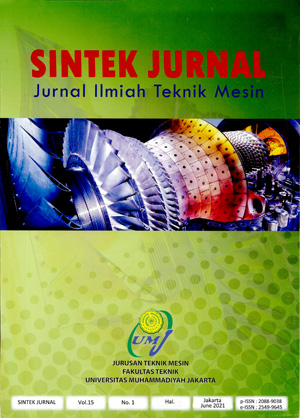LATTICE STRAIN ANALYSIS OF TITANIUM ROD PROCESSED BY EQUAL-CHANNEL ANGULAR PRESSING (ECAP) WITH Bc ROUTE USING X-RAY DIFFRACTION LINE BROADENING ANALYSIS
Main Article Content
Abstract
Article Details
- Articles published in SINTEK JURNAL are licensed under a Creative Commons Attribution-ShareAlike 4.0 International license. You are free to copy, transform, or redistribute articles for any lawful purpose in any medium, provided you give appropriate credit to the original author(s) and SINTEK JURNAL, link to the license, indicate if changes were made, and redistribute any derivative work under the same license.
- Copyright on articles is retained by the respective author(s), without restrictions. A non-exclusive license is granted to SINTEK JURNAL to publish the article and identify itself as its original publisher, along with the commercial right to include the article in a hardcopy issue for sale to libraries and individuals.
- By publishing in SINTEK JURNAL, authors grant any third party the right to use their article to the extent provided by the Creative Commons Attribution-ShareAlike 4.0 International license.
References
Kardashev, B. K., Narykova, M. V., Betekhtin, V. I., Kadomtsev, A. G. Evolution of Elastic Properties of Ti and its Alloys due to Severe Plastic Deformation. Physical Mesomechanics. 2020; 23: 193-198. doi: 10.1134/S1029959920030029.
Semenova, I. P., Polyakov, A. V., Raab, G. I., Lowe, T. C., Valiev, R. Z. Enhanced Fatigue Properties of Ultrafine-Grained Ti Rods Processed by ECAP-conform. Journal of Materials Science. 2012; 47: 7777-7781. doi: 10.1007/s10853-012-6675-9.
Manjunath, G. K., Udaya Bhat, K., Preetham Kumar, G. V., Ramesh, M. R. Microstructure and Wear Performance of ECAP Processed Cast Al-Zn-Mg Alloys. Transactions of the Indian Institute of Metals. 2018; 71: 1919-1931. doi: 10.1007/s12666-018-1328-6.
Suryanarayana, C. and Grant Norton, M. 1998. X-ray Diffraction: a Practical Approach. New York, New York: Plenum Press.
Dey, P. C., Das, R. Impact of Silver Doping on the Crystalline Size and Intrinsic Strain of MPA-Capped CdTe Nanocrystals: a Study by Williamson-Hall Method and Size-Strain Plot Method. Journal of Materials Engineering and Performance. 2021. doi: 10.1007/s11665-020-05358-9.
Erdogan, E. X-ray Line Broadening Study on Sputtered InGaN Semiconductor with Evaluation of Williamson-Hall and Size-Strain Plot Methods. Indian Journal of Physics. 2019; 93: 1313-1318. doi: 10.1007/s12648-019-01403-z.
Islam, S. A. U., Ikram, M. Structural Stability Improvement, Williamson Hall Analysis and Band-gap Tailoring through A-site Sr Doping in Rare Earth Based Double Perovskite La2NiMnO6. Rare Metals. 2019; 38: 805-813. doi: 10.1007/s12598-019-01207-4.
Kulkarni, A. B., Mathad, S. N. Synthesis and Structural Analysis of Co-Zn-Cd Ferrite by Williamson-Hall and Size-Strain Plot Methods. International Journal of Self-Propagating High-Temperature Synthesis. 2018; 27: 37-43. doi: 10.3103/S10613862180 1003X.
Madhavi, J. Comparison of Average Crystallite Size by X-ray Peak Broadening and Williamson-Hall and Size-Strain Plots for VO2+ Doped ZnS/CdS Composite Nanopowder. SN Applied Sciences. 2019; 1: 1509. doi: 10.1007/s42452-019-1291-9.
Norouzzadeh, P., Mabhouti, K., Golzan, M. M., Naderali, R. Consequence of Mn and Ni Doping on Structural, Optical and Magnetic Characteristics of ZnO Nanopowders: the Williamson-Hall Method, the Kramers-Kronig Approach and Magnetic Interactions. Applied Physics A. 2020; 126: 154. doi: 10.1007/s00339-020-3335-9.
Pushkarev, S. S., Grekhov, M. M., Zenchenko, N. V. X-ray Diffraction Analysis of Features of the Crystal Structure of GaN/Al0.32Ga0.68N HEMT-Heterostructures by the Williamson-Hall Method. Semiconductors. 2018; 52: 734-738. doi: 10.1134/S1063782618060209.
Kafashan, H. X-ray Diffraction Line Profile Analysis of Undoped and Se-Doped SnS Thin Films Using Scherrer’s, Williamson-Hall and Size-Strain Plot Methods. Journal of Electronic Materials. 2018; 48: 1294-1309. doi: 10.1007/s11664-018-6791-7.
Vajo, J. J., Adjorlolo, A. A., Graetz, J. Titanium-based Coatings and Methods for Making Coatings. EP3677705A2 (Patent). 2020.


